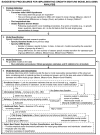Growth Mixture Modeling: A Method for Identifying Differences in Longitudinal Change Among Unobserved Groups
- PMID: 23885133
- PMCID: PMC3718544
- DOI: 10.1177/0165025409343765
Growth Mixture Modeling: A Method for Identifying Differences in Longitudinal Change Among Unobserved Groups
Abstract
Growth mixture modeling (GMM) is a method for identifying multiple unobserved sub-populations, describing longitudinal change within each unobserved sub-population, and examining differences in change among unobserved sub-populations. We provide a practical primer that may be useful for researchers beginning to incorporate GMM analysis into their research. We briefly review basic elements of the standard latent basis growth curve model, introduce GMM as an extension of multiple-group growth modeling, and describe a four-step approach to conducting a GMM analysis. Example data from a cortisol stress-response paradigm are used to illustrate the suggested procedures.
Figures



References
-
- Arbuckle JL. User’s Guide. Spring House, PA: Amos Development Corp; 1995–2008. AMOS.
-
- Bauer DJ, Curran PJ. Distributional assumptions of growth mixture models: Implications for overextraction of latent trajectory classes. Psychological Methods. 2003a;8:338–363. - PubMed
-
- Bauer DJ, Curran PJ. Overextraction of latent trajectory classes: Much ado about nothing? Reply to Risdskopf (2003), Muthen (2003), and Cudeck and Henly (2003) Psychological Methods. 2003b;8:384–393. - PubMed
-
- Bauer DJ, Curran PJ. The integration of continuous and discrete latent variable models: Potential problems and promising opportunities. Psychological Methods. 2004;9:3–29. - PubMed
-
- Bollen KA, Curran PJ. Latent curve models: A structural equation perspective. New York: Wiley; 2006.
Grants and funding
LinkOut - more resources
Full Text Sources
